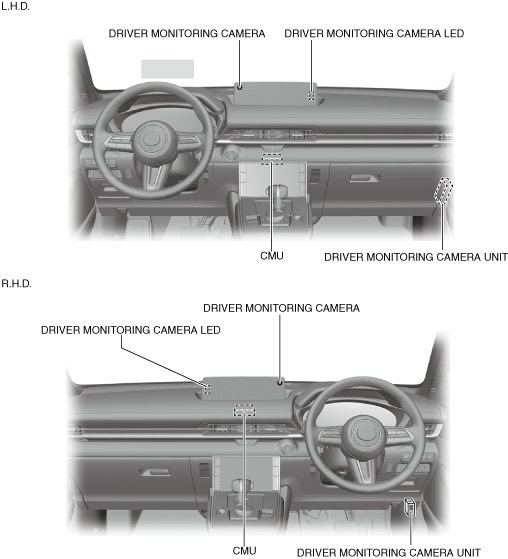DRIVER MONITORING (DM)
id151000005000
Outline
• The driver monitoring detects the driver’s behavior (inattentiveness and drowsiness level) using the camera inside the vehicle and secures the driver’s safety by activating a warning indication and warning sound to warn the driver if it determines a dangerous driving situation.
Structural view
Function
• The driver monitoring determines the driver’s drowsiness level based on the driver’s eyelid information and warns the driver.
Driver monitoring function
-
• The driver monitoring (DM) monitors the driverÅfs behavior (inattentiveness and drowsiness level).
Warning function
-
• If the driver monitoring (DM) detects driver drowsiness while monitoring the driver, it displays a warning screen on the multi-information display and activates a warning sound according to the drowsiness level.
• There are two types of patterns set for the warning.
-
― Warning pattern (caution) : Fatigue or drowsiness detected
― Warning pattern (warning) : Extreme fatigue or drowsiness detected
Personalization feature
-
• The driver monitoring system can be switched between ON (operational)/OFF (non-operational) (initial setting is ON (operational)). For details on personalization features, refer to [PERSONALIZATION FEATURES] in the workshop manual.
System wiring diagram
Operation
Timing chart
Driver monitoring function
• The driver monitoring (DM) monitors the driver when all of the following conditions are met.
-
― Driver monitoring camera is functioning normally
― Vehicle speed calculated by body control module (BCM) is approx. 5 km/h or more for continuous 20 min or more
-
Note
-
• Once the vehicle speed becomes less than approx. 5 km/h, the driver monitoring (DM) will monitor the driver for approx. 3 min after the vehicle speed returns to approx. 5 km/h or more.
Warning function
1. The driver monitoring camera unit sends the driver information (driver's head position, face direction, line of vision, opening/closing angle of driverÅfs eyes, and opening/closing angle of driverÅfs mouth) (1) taken by the driver monitoring camera to the connectivity master unit (CMU) through the body control module (BCM) via CAN communication.
2. The CMU calculates (2) the driver’s drowsiness level based on the driver’s eyelid information (1) received from the driver monitoring camera unit and if it determines a dangerous driving situation, it sends a warning indication request signal (3) to the instrument cluster through the BCM via CAN communication.
3. The instrument cluster displays the warning screen (4) on the multi-information display, and the BCM activates the warning sound (4) from the notification and warning speaker (front).
-
Note
-
• After warning pattern (caution) is activated, it will not be activated again for approx. 45 min.
• After warning pattern (warning) is activated, it will not be activated again for approx. 15 min.
• After warning pattern (warning) is activated, warning pattern (caution) will not be activated for approx. 45 min.
• If the vehicle speed is less than approx. 5 km/h, the warning function will not be activated for approx. 6 min. even if the vehicle speed reaches approx. 5 km/h or more after that.
• The driver information is used to accelerate the warning timing of the smart brake support (SBS).
